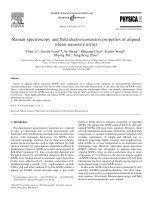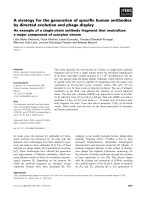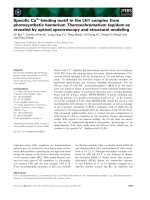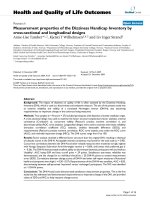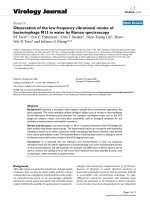- Trang chủ >>
- Khoa học tự nhiên >>
- Vật lý
DISCRIMINATION OF COLOR COPIER/LASER PRINTER TONERS BY RAMAN SPECTROSCOPY AND SUBSEQUENT CHEMOMETRIC ANALYSIS
Bạn đang xem bản rút gọn của tài liệu. Xem và tải ngay bản đầy đủ của tài liệu tại đây (2.04 MB, 81 trang )
Graduate School ETD Form 9
(Revised 12/07)
PURDUE UNIVERSITY
GRADUATE SCHOOL
Thesis/Dissertation Acceptance
This is to certify that the thesis/dissertation prepared
By
Entitled
For the degree of
Is approved by the final examining committee:
Chair
To the best of my knowledge and as understood by the student in the Research Integrity and
Copyright Disclaimer (Graduate School Form 20), this thesis/dissertation adheres to the provisions of
Purdue University’s “Policy on Integrity in Research” and the use of copyrighted material.
Approved by Major Professor(s): ____________________________________
____________________________________
Approved by:
Head of the Graduate Program Date
Evan Robert Himes
The Role of STAT3 in Osteoclast Mediated Bone Resorption
Master of Science
Jiliang Li
Robert Yost
Melissa Kacena
Jiliang Li
Simon Atkinson
07/09/2013
i
i
THE ROLE OF STAT3 IN OSTEOCLAST MEDIATED BONE RESORPTION
A Thesis
Submitted to the Faculty
of
Purdue University
by
Evan Himes
In Partial Fulfillment of the
Requirements for the Degree
of
Master of Science
August 2013
Purdue University
Indianapolis, Indiana
ii
ii
For my family
iii
iii
ACKNOWLEDGEMENTS
I would like to thank my advisor Dr. Jiliang Li for all his help and guidance and
my committee members: Dr. Melissa Kacena and Dr. Robert Yost. I would also like to
thank Dr. Kacena and her lab for their help with the osteoclast cell culture, Dr. Keith
Condon and Yongqi Yu for their help with histology, Kevin Zhou for his guidance,
Tomas Meijome and Ryne Horn for their help with osteoclast isolation and mechanical
testing, and all other members of Dr. Li’s lab, including Kimberly Ho-A-Lim, Layla
Mihuti, Samantha Lenz, Tiffany Riddle, and Lindsay Egan.
iv
iv
TABLE OF CONTENTS
Page
LIST OF TABLES vii
LIST OF FIGURES viii
LIST OF ABBREVIATIONS x
ABSTRACT xiii
CHAPTER 1. INTRODUCTION 1
1.1 Skeletal Structure 1
1.2 Bone Macroscopic Anatomy 1
1.3 Bone Modeling 3
1.4 Bone Remodeling 3
1.5 Bone Cells 4
1.6 The Osteoclast 5
1.7 Enzymes Involved in Bone Resorption 7
1.7.1 Cathepsin K (CTSK) 7
1.7.2 Tartrate Resistant Acid Phosphatase (TRAP) 7
1.8 Osteoclast Regulation 7
1.9 Bone Biomechanics 8
1.10 Hyper-IgE Syndrome 9
1.11 Signal Transducers and Activators of Transcription 10
1.12 JAK-STAT Pathway 11
1.13 STAT3 Structure 11
1.14 STAT3 Activation 13
1.15 STAT3 Localization 14
1.16 Regulators of STAT3 14
1.17 STAT3 Knockout Mouse Model 15
v
v
Page
1.18 STAT3 in Bone 15
1.19 Research Goals 16
CHAPTER 2. MATERIALS AND METHOD 17
2.1 Conditional STAT3 Knockout Mice 17
2.2 PCR for STAT3 and Cre Genes 18
2.3 Immunohistochemistry 19
2.4 Bone Mineral Density (PIXImus) 20
2.5 Mechanical Testing 20
2.6 Micro CT 21
2.7 Osteoclast Cell Culture 21
2.8 Histology 22
2.8.1 Tartrate Resistant Acid Phosphatase (TRAP) Stain 22
2.8.2 VKM Stain 23
2.9 Histomorphometry 23
2.10 Statistics 24
CHAPTER 3. RESULTS 25
3.1 Verification of Osteoclast Specific Knockout Mice 25
3.2 Comparison of Mouse Body Weight and Femur Length 25
3.3 CTSK Specific Knockout Female Mice Decrease in BMD 26
3.4 CTSK Specific KO Mice Trabecular Bone at 8 Weeks Old 26
3.5 CTSK Specific KO Mice Trabecular Bone 16 Week of Age 27
3.6 CTSK Specific KO Increases the Number of Osteoclasts 28
3.7 CTSK Specific STAT3 KO Trabecular BFR at 8 Weeks Old 28
3.8 Cortical Bone Size and Growth Rate in STAT3 KO Mice 29
3.9 Mechanical Testing: 3 Point Bending 29
3.10 Osteoclast Cell Culture 30
CHAPTER 4. DISCUSSION 31
4.1 Decreased Osteoclast Number in STAT3 KO 31
4.2 Osteoclast Number and BV/TV in Trabecular Bone 31
4.3 Differences in Bone Phenotypes at age 8 and 16 Weeks 32
vi
vi
Page
4.4 Males Exhibit Stronger Cortical Bone In STAT3 KO 33
4.5 Future Plans 33
LIST OF REFERENCES 35
TABLES 40
FIGURES 41
vii
vii
LIST OF TABLES
Table Page
Table 1 Abbreviations and formulas for parameters used in cortical bone 40
Table 2 Abbreviations and formulas for parameters used in trabecular bone 41
viii
viii
LIST OF FIGURES
Figure Page
Figure 1: Osteons 42
Figure 2: Bone remodeling units 43
Figure 3: Stress-stain curve and force-displacement curve 44
Figure 4: STAT3 activation 45
Figure 5: STAT3 crystalline structure 46
Figure 6: Membrane receptors for IL-6 family cytokines 47
Figure 7: Determination of mouse genotype 48
Figure 8: Mechanical testing 49
Figure 9: Immunohistochemical staining 50
Figure 10: Body weights of osteoclast specific Stat3 mice 51
Figure 11: Femur length of osteoclast specific STAT3 KO mice 52
Figure 12: BMD and BMC of 8 week CTSK STAT3 KO mice 53
Figure 13: BMD and BMC of adult CTSK mice 54
Figure 14: BMD and BMC of 8 week old TRAP STAT3 KO mice 55
Figure 15: Trabecular bone structure of 8 week old CTSK mice 56
Figure 16: Trabecular bone structure of 16 week old CTSK mice 57
Figure 17: TRAP stain CTSK specific STAT3 KO mice 58
ix
ix
Page
Figure 18: TRAP stain TRAP specific STAT3 KO mice 59
Figure 19: Dynamic histomorphometry CTSK mice 60
Figure 20: Dynamic histomorphometry TRAP mice 61
Figure 21: Cortical bone properties 8 week old CTSK STAT3 mice 62
Figure 22: Mechanical testing of CTSK mouse femur 63
Figure 23: Osteoclast cell culture data 64
x
x
LIST OF ABBREVIATIONS
ACP: Avidin-conjugated peroxidase
ARIP: Activin receptor interacting protein 1
BMC: Bone mineral content
BMD: Bone mineral density
BRU: Bone Remodeling Unit
BMP: Bone morphogenic protein
CNTF: Ciliary neurotrophic factor
CT-1: Cardiotrophin-1
CTSK: Cathepsin K
Dlx5: Distal-less homeobox 5
DNA: Deoxyribonucleic acid
EGF: Epidermal growth factor
EDTA: Ethylenediaminetetraacetic acid
FBS: Fetal bovine serum
FCS: Fetal calf serum
FGF: Fibroblast growth factor
GAS: Gamma Activated Sequences
gp130: Glycoprotein 13
xi
xi
GTP: Guanosine triphosphate
HIES: Hyper-IgE Syndrome
H
2
O
2
: Hydrogen peroxide
IACUC: Institutional Animal Care and Use Committee
IFN: Interferon
IgE: Immunoglobulin E
IL: Interleukin
JAB: JAK-binding protein
JAK: Janus Kinase
KCl: Potassium Chloride
LIF: Leukemia Inhibitory Factor
M-CSF: Macrophage colony-stimulating factor
MMP: Matrix metalloproteinase
NP-40: Nonyl phenoxypolyethoxylethanol
OPG: Osteoprotegrin
OSM: Oncostatin M
PBS: Phosphate buffered saline
PCR: Polymerase chain reaction
PDGF: Platelet-derived growth factor
PIAS: Protein inhibitors of activated STAT
RANKL: Receptor activator of nuclear factor kappa-B ligand
RGD: Arginine-Glycine-Aspartic acid
ROS: Reactive oxygen species
xii
xii
Runx2: Runt-related transcription factor 2
SH2: Src Homology 2
siRNA: Small interfering ribonucleic acid
SOCS: Suppressors of cytokine signaling
SSI: STAT-induced STAT inhibitor
STAT: Signal transducer and activator of transcription
TGF: Transforming growth factor
TRAP: Tartrate-resistant acid phosphatase
Tyk2: Non-receptor tyrosine-protein kinase
VKM: Von Kossa Method with MacNeal’s Tetrachrome Counterstain
µCT: Micro-computed tomography
αMEM: α Minimal essential medium
xiii
xiii
ABSTRACT
Himes, Evan R. M.S., Purdue University, August 2013. The Role of STAT3 in Osteoclast
Mediated Bone Resorption. Major Professor: Jiliang Li.
Signal Transducer and Activator of Transcription 3 (STAT3) is known to be
related to bone metabolism. Mutation of STAT3 causes a rare disorder in which serum
levels of IgE are elevated. This causes various skeletal problems similar to osteoporosis.
To examine the effect of STAT3 in the osteoclast, we obtained two osteoclast
specific STAT3 knockout mouse models: one using the CTSK promoter to drive Cre
recombinase and another using a TRAP promoter. Examination of these mice at 8 weeks
of age revealed a decreased trabecular bone volume in CTSK specific STAT3 knockout
mice along with a slight decrease in osteoclast number in both CTSK and TRAP specific
STAT3 knockout females. We also noticed changes in bone mineral density and bone
mechanical strength in females. These data suggest that STAT3 plays a part in the
function of the osteoclast.
1
1
CHAPTER 1. INTRODUCTION
1.1 Skeletal Structure
The skeleton of the adult human is made up of 206 bones carrying out various
tasks, such as providing a framework to move and support the body, protection of vital
organs, and playing a part in mineral homeostasis. Bones may be divided into several
groups, including long bones such as those found in the limbs (femur, humerus) and flat
bones such as the bones of the skull. The long bones are further divided into the
epiphysis, metaphysis, and diaphysis. The diaphysis is a long and hollowed out shaft that
spans most of the bone. The metaphysis is the portion of bone between the diaphysis and
the growth plate, while the epiphysis is the region beyond the growth plate at each end of
the bone [1].
1.2 Bone Macroscopic Anatomy
The inner and outer surfaces of bone are covered in fibrous sheaths. The outer
surface is covered in the periosteum, with the exception of areas where joints are located.
The periosteum is anchored to the underlying bone by collagenous fibers called
2
2
Sharpey’s fibers. The periosteum contains the blood vessels and nerves running to the
bone, along with osteoblasts and osteoclasts, two cells responsible for building up and
breaking down of bone tissue, respectfully.
The endosteum covers the inner surface of the bone and similar to the periosteum,
the endosteum also contains blood vessels, nerves, osteoblasts, and osteoclasts.
Volkman’s canals and Haversian canals which contain blood vessels run through the
bone [1].
All bone is arranged in two different formats, cortical bone and cancellous or
trabecular bone. Overall, the human skeleton contains more cortical bone than trabecular
bone, but this can vary between different locations of the skeleton. Cortical bone appears
to be very dense while trabecular bone appears to be a network of rods running between
the cortical bone. Both cortical and trabecular bone is made up of the same basic
functional unit: the osteon. Osteons are arranged into Haversian systems in cortical bone
and saucers in trabecular bone. (Figure 1) The Haversian systems form cylinders running
the length of cortical bone and are made of concentric circles of lamellae. In trabecular
bone, the lamellae are stacked together to form saucer-shaped osteons. [1]
The extracellular matrix of bone is composed of a protein network and a mineral
component. The organic protein component gives the bone elasticity, while the mineral
gives the bone strength. The majority of the protein in bone is type 1 collagen, which is
made from two α1 chains and one α2 chain. [2] Smaller amounts of type III and V
collagens are also present. [3] The remaining 10-15% of the protein component is made
of non-collagenous proteins. About ¼ of these are exogenously made serum proteins that
have an affinity for hydroxyapatite. [4] The remaining non-collagenous proteins are
3
3
broken into four groups: proteoglycans, glycosylated proteins, glycosylated proteins with
cell attachment properties, and γ-carboxylated proteins. The mineral component makes
up between 50-70% of bone in an adult and is composed of hydroxyapatite,
[Ca
10
(PO
4
)
6
(OH)
2
]. This mineral is initially deposited in sites left open by the collagen
fibrils. These crystals become larger as the bone matures and aggregate as they increase
in size. [5-7]
1.3 Bone Modeling
Bone structure can be changed through two different processes: modeling and
remodeling. In bone modeling, the osteoblasts or osteoclasts shape the bone through
either resorption or formation. As an example, the continuous use of an arm can change
the size of the radius in tennis athletes. [8] Bone modeling is more common among
children who are still growing than in adults. In remodeling, bone resorption and
formation are coupled. This involves the breakdown of bone by osteoclasts immediately
followed by new bone formation by osteoblasts. [1]
1.4 Bone Remodeling
Remodeling is broken down into 4 phases: activation, resorption, reversal, and formation.
The cells involved in this process arrange themselves in a bone remodeling unit, or BRU
(Figure 2). [9] During activation, mononucleated osteoclast precursors are recruited and
fused into multinucleated cells. These preosteoclasts attach to the bone via integrins,
4
4
forming a sealed environment within which they can degrade the bone matrix. [10]
Destruction of the bone matrix by the osteoclasts begins after activation and is explained
below. Reversal begins after the death of the osteoclasts. The bone is covered by a
variety of cells during this phase, including monocytes, exposed osteocytes, and
preosteoblasts. [1]
During formation, osteoblasts first synthesize a protein matrix and then regulate
mineral deposition through secretion of membrane vesicles. These vesicles contain
calcium and phosphate ions and enzymes to degrade inhibitors of mineralization.[11]
After bone formation the osteoblasts can become osteocytes as they are trapped within
the bone or bone lining cells. However, the majority of osteoblasts undergo apoptosis at
the end of bone formation. [1] Bone remodeling differs from modeling in that resorption
and formation occur on the same bone surface during remodeling.
1.5 Bone Cells
Bone is comprised of three cell types: osteoblasts, osteocytes, and osteoclasts.
The osteoblasts are responsible for building the bone matrix, while osteoclasts are
responsible for breaking down bone matrix. Osteocytes are thought to be involved in
signaling processes. Both osteoblasts and osteocytes come from the mesenchymal stem
cell lineage, while the osteoclasts arise from hematopoietic stem cells. [12]
5
5
The commitment of mesenchymal stem cells to become osteoblasts is mediated
by multiple factors, including Runx2, osterix, and Dlx5. [13] Bone morphogenic proteins
are also inducers of osteoblast formation. These are members of the TGF-β superfamily
and include BMP-2, BMP-4, and BMP-7. [14]
Osteocytes are the final stage of differentiation for osteoblasts. Osteocytes are
located within lacunae in the bone matrix and have long extensions into the canaliculi,
through which they communicate. Osteocytes produce large amounts of osteocalcin,
galectin-3, and CD44. [14]
1.6 The Osteoclast
The osteoclast is responsible for bone resorption and, unlike osteoblasts and
osteocytes, come from the monocyte/macrophage lineage. [15] Osteoclasts are
developed in vitro with the addition of receptor activator of nuclear factor kappa-B ligand
(RANKL) and macrophage colony-stimulating factor (M-CSF). [16, 17] Both proteins
are produced by osteoblasts.
Osteoclasts resorb bone through the formation of a sealed environment between
the cell and the underlying bone. This is accomplished using integrins, which are
transmembrane receptors made of one α and one β subunit. [18] Specifically, the αvβ3
integrin is responsible for osteoclast-bone attachment. The αvβ3 binds to RGD motifs,
found on various bone related protein, including bone sialoprotein and osteopontin. The
αvβ3 integrin was discovered to be necessary for osteoclast attachment in a study using a
6
6
β3 integrin knock out mouse, which led to an increase in bone mass. [19] Inhibition of
osteoclast binding through αvβ3 is a target under study for treatment of osteoporosis. [20]
The osteoclast requires a specialized cytoskeleton to function correctly. Binding
to bone causes the osteoclast cytoskeleton to form two unique structures: the ruffled
membrane and the sealing zone. The ruffled membrane gets its name from the shape
created by the vesicles carrying cathepsin K, a lysosomal enzyme secreted by the
osteoclast, and matrix metalloproteinases (MMPs) to the cell surface. [21] This area also
houses proton pumps and a chloride ion channel used to bring the pH of this
microenvironment to approximately 4.5 which dissolves bone’s mineral component,
leaving the organic component behind. [22] The organic matrix is primarily type 1
collagen, which is broken down by enzymes such as cathepsin K and tartrate-resistant
acid phosphatase. The sealing zone is made from fibrillar actin and serves to separate the
area being resorbed by the osteoclast from the surrounding environment. [23]
Osteoclast rearrangement is mediated through integrin signaling and the Rho
family of small GTPases. Integrin signaling through the adaptor protein c-Src stimulates
formation of the ruffled membrane [24]. Both Rho and Rac translocate to the
cytoskeleton after binding GTP. Rho signalling leads to formation of the actin ring, [25,
26] while Rac signaling stimulates the formation of lamellipodia, which allows the
osteoclast to migrate. [27]
7
7
1.7 Enzymes Involved in Bone Resorption
1.7.1 Cathepsin K (CTSK)
CTSK is an enzyme responsible for breaking down the organic matrix of bone.
CTSK is primarily expressed by the osteoclast, with some expression occurring in the
lung. [28] The gene for CTSK is found on chromosome 1 and transcription of CTSK is
activated by RANKL and M-CSF. Transforming growth factor β1 (TGFβ1) and
interleukin 10 (IL-10) both inhibit CTSK, which has a molecular mass of 24 kDa and
consists of two domains, forming a v-shaped active site. [29]
1.7.2 Tartrate Resistant Acid Phosphatase (TRAP)
TRAP is a 35kDa metalloenzyme that breaks down phosphate esters or
anhydrides. [30] While TRAP is primarily expressed in bone, it can also be found in the
colon, kidney, liver, and testes. [28] TRAP has a molecular weight of about 35 kDa.
Osteoclasts are commonly identified by staining for cells expressing TRAP.
1.8 Osteoclast Regulation
RANKL and M-CSF are the most well-known activators of osteoclastogenesis.
RANKL is inhibited by Osteoprotegrin (OPG), a competitive inhibitor of RANKL. Both
RANKL and OPG are produced by the osteoblast. [31] Interferon-γ (IFN-γ) also
8
8
suppresses osteoclast function [32] and vitamin D increases RANKL concentration
while decreasing Osteoprotegrin levels, causing an increase in bone volume. [31]
The hormone estrogen prevents bone resorption and loss of estrogen in the aging
process has been shown to contribute to bone loss. [33] Estrogen upregulates osteoblast
formation through bone morphogenic protein 4 (BMP-4). [34] Glucocortocoids act as
negative osteoclast regulators by increasing osteoblast apoptosis which leads to a
decrease in RANKL. [35]
1.9 Bone Biomechanics
Bone can be strengthened in two ways: through the addition of more bone to help
carry a load or through improving the bone’s material composition. Bone strength can be
quantified by various measurements, such as strain and stress. Strain is the change in
length of an object divided by its original length and therefore has no unit. A strain can
be tensile if the material is being stretched or compressive if the material is being pushed
together. Shear stress is the angle of deformation by a force that is running parallel to the
material, and is generated in bone during rapid changes in direction. Stress is a measure
of force per unit area. [36]
Modulus is another measure of strength and is the slope of the initial linear part of
the stress vs. strain curve (Figure 3). This is also referred to as the elastic part of the
curve since the removal of force allows the object being tested to return to its original
state undamaged. The linear relationship of the stress-strain curve is also referred to as
9
9
Hooke’s Law. The slope of the stress-strain curve in the elastic region is a measure of a
material’s stiffness. A larger slope of the stress-strain curve equals a higher stiffness. [36]
Two points of failure are observed when testing the strength of a material: yield
failure and ultimate failure. Yield failure is the point where stress and strain do not have
a linear relationship and is the point where permanent damage occurs. The region
beyond this point on the stress-strain curve is referred to as the plastic region. Ultimate
failure is the point at which the material being tested fails catastrophically. Toughness is
a measure of a material’s ability to resist fracture when put under a sudden load. [36]
1.10 Hyper-IgE Syndrome
Hyperimmunoglobulin E syndrome (HIES), also known as Job’s syndrome, was
originally discovered in 1966 by Davis et al. They described symptoms as a recurrent
‘cold’ and staphylococcal abscess. [37] HIES was and named in 1972 by Buckley at al.
and characterized as having an increase in IgE concentration of up to 10 times the normal
serum levels. [38]
HIES results in various infections and skeletal abnormalities as well as dental
problems, including retained primary teeth and also failure of permanent teeth to erupt or
permanent tooth eruption next to primary teeth, resulting in two rows of teeth. Eczema,
skin abscesses, pneumonia, and candidiasis of the nail bed and mucus membranes are
common. HIES patients also have an increased risk of bone fracture as shown in 1999 by
Grimbacher et al. [39] Most fractures in the 30 patient study were a result of everyday
10
10
tasks, including diaper changing and line dancing The majority of these fractures were in
long weight-bearing bones such as the femur along with the ribs and pelvis.
When fractures do occur, bacterial arthritis and osteomyelitis can be found. The
study also found that scoliosis occurred in 76% of HIES patients. HIES can result in
hyperextensible joints and a distinctive facial appearance, including an asymmetrical
face, deep-set eyes, a broad nose, and a prominent forehead. [39, 40]
HIES is caused by one of two genetic mutations, autosomal-recessive HIES and
autosomal-dominant HIES. [41] Both have been linked to chromosome 4. [42] A 2007
study by Holland et al. determined mutations of STAT3 was the cause of HIES. [43] All
mutations were in either the DNA binding region or SH2 domain of STAT3.
1.11 Signal Transducers and Activators of Transcription
STAT3 is one of a family of 7 STAT proteins which includes Stat1, Stat2, Stat3,
Stat4, Stat5a, Stat5b, and Stat6. The Stat proteins are part of the Janus kinase (JAK)-
STAT signaling pathway. The JAK family of proteins includes JAK1, JAK2, JAK3, and
Tyk2. [44] This pathway was originally discovered while looking at the actions of
interferons. The STAT genes are located on multiple chromosomes: STAT1 and STAT4
are on chromosome 2, STAT3 STAT5a and STAT5b are located on chromosome 12, and
STAT2 and STAT6 are on chromosome 17. All STATs are activated by phosphorylation
of a tyrosine residue located around position 700. The STATs range in size between 750
and 850 amino acids long. [45]
11
11
1.12 JAK-STAT Pathway
The JAK-STAT pathway can be activated in many ways. Activation occurs with
the binding of one of the interlukin-6 (IL-6) type cytokines to their receptors. This family
of cytokines is also referred to as the gp130 family and consists of IL-6, IL-11, oncostatin
M, leukemia inhibitory factor, cardiotrophin-1, and the novel neurotrophin-1/B-cell
stimulatory factor-3. [46, 47] When these cytokines bind their respective receptors gp130
dimerizes, therefore activating JAK. Once JAK is activated it phosphorylates a tyrosine
in a YXXQ motif of the receptor’s cytoplasmic tail. The phosphorylated receptor then
attracts the SH2 domain of a STAT, which then becomes phosphorylated at a tyrosine.
This leads to the dimerization of the STAT and the movement of the dimerized STAT to
the nucleus, where it can bind DNA and act as a transcription activator. [48] The JAK-
STAT pathway can also be activated by STAT phosphorylation by epidermal growth
factor (EGF) or platelet-derived growth factor (PDGF). In addition, JAKs may be
activated by G-protein –coupled receptors (Figure 4). [49]
1.13 STAT3 Structure
STAT3 contains multiple domains, each with a different function. The N-domain,
coiled-coil domain, linker domain, DNA binding domain, SH2 domain, and carboxy
terminal transcriptional activation domain all make up the STAT3 protein. [50] (Figure 5)


